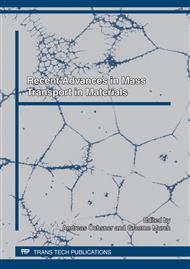[1]
G. Yu. Arzhadeeva, A.N. Dmitriev, Z.N. Pastukhova, Yu.A. Chesnokov: Quality of iron-ore raw materials and coke – reserve of technological development of blast furnace smelting. Proceedings of the Seventh international scientifically-practical conference Research, development and application of high technologies in the industry,. April 28-30, 2009, St. -Petersburg, Russia. Pp. 301–302.
DOI: 10.4028/www.scientific.net/ddf.322.87
Google Scholar
[2]
A.N. Dmitriev, N.S. Shumakov, L.I. Leontev, O.P. Onorin: Foundation of a blast furnace process theory and technology. Ekaterinburg: Ural Branch of Russian Academy of Sciences, 2005. P. 547.
Google Scholar
[3]
A.V. Chentsov, Yu. A. Chesnokov, S.V. Shavrin: Logic-statistic balance model of blast furnace smelting process. Ekaterinburg: Ural Branch of Russian Academy of Sciences, 2003. P. 164.
Google Scholar
[4]
A.N. Dmitriev, Yu.A. Chesnokov: Reduction Kinetics of Iron Ore Materials by Gases. Defect and Diffusion Forum Vols. 283–286 (2008), p.45–52.
DOI: 10.4028/www.scientific.net/ddf.283-286.45
Google Scholar
[5]
A.N. Dmitriev, V.P. Perepechaev, Yu.A. Chesnokov: Influence of Elemebts Oxides Microadditives with Major Cationic Radius on Properties of Silicate Bundle. Defect and Diffusion Forum Vols. 297–301 (2010), p.1295–1300.
DOI: 10.4028/www.scientific.net/ddf.297-301.1295
Google Scholar
[6]
G.Y. Arzhadeeva, A.N. Dmitriev, Yu.A. Chesnokov: Investigation of influence of qualitative iron ore materials characteristics on parameters of a blast furnace process. Proceedings of the Ninth international scientifically-practical conference Research, development and application of high technologies in the industry,. April 22-23, 2010, St. -Petersburg, Russia. Pp. 175–176.
DOI: 10.4028/www.scientific.net/ddf.322.87
Google Scholar
[7]
A.N. Dmitriev: The role of reducibility in achievement of the minimal coke consumption in the blast furnace smelting. Defect and Diffusion Forum Vols. 258–260 (2006), p.91–100.
DOI: 10.4028/www.scientific.net/ddf.258-260.91
Google Scholar
[8]
V.A. Kobelev, V.P. Puzanov: To a problem of sinter reducibility. Steel № 12 (2000), p.6–8.
Google Scholar
[9]
L.I. Leontev, Y.S. Yusfin, T.Y. Malysheva: Iron ore and fuel base of ferrous metallurgy. Moscow: Academic Book, 2007. P. 304.
Google Scholar
[10]
Yu.P. Volkov, L. Yu. Shparber, A.K. Gusarov: Operation of blast furnaces. М.: Metallurgy, 1991. P. 240.
Google Scholar
[11]
Yu.V. Stepanov: About methods of definition and an estimation of quality of coke. Ferrous metallurgy № 1 (2005), p.24–32.
Google Scholar
[12]
A.N. Dmitriev, Yu.A. Chesnokov, G. Yu. Arzhadeeva: Mathematical Model of Forecasting of Coke Quality Indicators. Defect and Diffusion Forum Vols. 297–301 (2010), p.1290–1294.
DOI: 10.4028/www.scientific.net/ddf.297-301.1290
Google Scholar
[13]
N.M. Mozharenko: Trial of test of the coke received on new technologies. Fundamental and applied problems of ferrous metallurgy. Ukraine, 2008. № 16. Pp. 187–195.
Google Scholar
[14]
A.N. Dmitriev, Yu.A. Chesnokov, G. Yu. Arzhadeeva, Yu.P. Lazebnaya: Mathematical Model of Forecasting the Iron Ore Materials and Coke Quality Indicators. Defect and Diffusion Forum Vols. 312–315 (2011), p.1198–1203.
DOI: 10.4028/www.scientific.net/ddf.312-315.1198
Google Scholar
[15]
M.G. Ladygichev, V.M. Chizhikova, V.I. Lobanov et al.: Raw materials for ferrous metallurgy. Т. 1. The Raw-material base and manufacture raw materials (raw materials, technologies, the equipment). – М: Mashinostroenie-1, 2001. P. 896.
Google Scholar
[16]
S.D. Abramov, S.V. Shavrin, A.V. Chentsov: Estimation of characteristics of the coke defining its reactionary ability. Reduction, heat exchange and hydrodynamics in blast furnace process. – Sverdlovsk, 1970. Pp. 32–48.
Google Scholar
[17]
V.E. Kogan, G.S. Zenin, N.V. Penkin: Physical chemistry. Part 2. Chemical kinetics. – SPb, 2005. P. 226.
Google Scholar
[18]
S.G. Melamud, B.P. Jurev, L.B. Brook: Working of ways of reception strong pellets at reduction. News High School. Ferrous Metallurgy № 2 (2002), p.3–6.
Google Scholar
[19]
N.G. Mahanek: Features of heat exchange in a blast furnace. Works of the Ural polytechnical institute. The collection № 105. – Sverdlovsk: Metallurgizdat, 1960. Pp. 90–106.
Google Scholar
[20]
Burden materials, coke, operation and indicators of work of blast furnaces. On materials of 4th European congress on chemical-recovery and blast furnace manufacture. Steel № 3 (2001), p.7–13.
Google Scholar
[21]
A. Beppler, K. -X. Grospich, G. Luis et al.: Influence of quality of coke on blast furnace work. Ferrous Metals № 10 (1999), p.10–18.
Google Scholar
[22]
G.G. Vasura: Estimation of the technology factors influencing efficiency of a blast furnace smelting. Steel № 9 (2005), p.3–8.
Google Scholar
[23]
V.I. Gladyshev, N.N. Gorshkov, A.V. Denisov et al.: Complex estimation of influence of quality of coke for work of the blast furnace. Steel № 3 (2002), p.48–51.
Google Scholar
[24]
V.I. Gladyshev, N.N. Gorshkov, A.V. Denisov et al.: Estimation of dependence of the coke from manufacture parameters. Steel № 3 (2001), p.3–6.
Google Scholar
[25]
A.N. Dmitriev: Heat and mass transfer in blast furnace in conditions of non-uniform movement of material and gas. Proceedings of The First International Conference on Diffusion in Solids and Liquids DSL-2005, July 6-8, 2005, University of Aveiro, Aveiro, Portugal. – 2005. Volume I. Pp. 181-186.
Google Scholar
[26]
B.I. Kitaev, V.V. Timofeev, B.A. Bokovikov et al.: Heat and mass exchange in a dense layer. Moscow: Metallurgy, 1972. P. 432.
Google Scholar
[27]
A.N. Dmitriev: The role of reducibility in achievement of the minimal coke consumption in the blast furnace smelting. Defect and Diffusion Forum Vols. 258-260 (2006), pp.91-100.
DOI: 10.4028/www.scientific.net/ddf.258-260.91
Google Scholar


